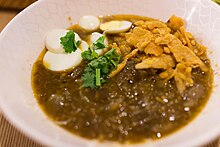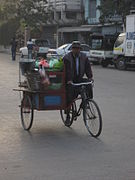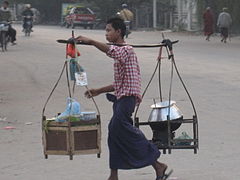Mohinga (Burmese: မုန့်ဟင်းခါး; MLCTS: mun.hang: hka:, IPA: [mo̰ʊɰ̃hɪ́ɰ̃ɡá]; also spelt mont hin gar) is a rice noodle and fish soup from Myanmar and an essential part of Burmese cuisine, considered by many to be the national dish of Myanmar.[1][2][3] Mohinga is readily available in most parts of the country, sold by street hawkers and roadside stalls in larger cities. Mohinga is traditionally eaten for breakfast, but today is eaten at any time of day.
 Mohinga with fritters | |
| Alternative names | Mont hin gar |
|---|---|
| Course | Breakfast |
| Place of origin | Myanmar |
| Associated cuisine | Burmese cuisine |
| Main ingredients | Rice vermicelli, catfish |
| Ingredients generally used | Fish sauce, fish paste, ginger, banana stem, lemongrass, onions, garlic, chickpea flour |
| Variations | Many; see §Regional varieties below |
Description and ingredients
The main ingredients of mohinga are gram flour and/or crushed toasted rice, garlic, shallots or onions, lemongrass, ginger, fish paste, fish sauce, and catfish (or other types of fishes, such as Mrigal carp).[3] The ingredients are combined in a rich broth, which is cooked and kept on the boil.[3][4] Mohinga is served with rice vermicelli, dressed and garnished with fish sauce, a squeeze of lime, crisp fried onions, coriander, spring onions, crushed dried chillis, and, as optional toppings, deep-fried Burmese fritters such as split chickpeas, urad dal, gourd, sliced pieces of youtiao, as well as boiled egg and fried ngapi fish cake.[3][5] Mohinga is eaten with Chinese soup spoons, which are known as mohinga zun (lit. 'mohinga spoons') in Burmese.[3]
Mohinga is a very common breakfast dish in Myanmar, and available as an "all-day breakfast" in many towns and cities.[1][3][6] Mohinga can be served as a formal dish made from scratch as well as from a ready-made powder used for making the broth. Mohinga used to be available only early in the morning and at street pwès (open air stage performances), zat pwès (open air dance performances) or theatres at night. Street hawkers often sell mohinga, with some carrying the soup cauldron on a stove on one side of a shoulder pole, with rice vermicelli and other ingredients, along with bowls and spoons, on the other.[5] Trishaw peddlers began to appear in the 1960s and some of them set up pavement stalls making mohinga available all day.[citation needed]
- A mohinga trishaw peddler in Mandalay will stop for customers.
- Mohinga is available all day from pavement stalls such as this in Mandalay.
- Ready-made packages containing powder to cook mohinga soup is also available.
- Mohinga streethawker in Mandalay
History and origins
The origins of mohinga are difficult to pinpoint in the absence of extant records.[7] Food processing tools used to ferment rice dating to the Pyu city-states have been discovered, showing that the tradition of making rice vermicelli, the key starch used in mohinga, has a long history. The earliest reference to mohinga dates to the Konbaung dynasty, in the poet U Ponnya's alinga verse poem.[7] Burmese history historian Khin Maung Nyunt has concluded that during pre-colonial times, mohinga was likely a commoner's dish, as a formal recipe for mohinga has not been found in royal records or cookbooks.[7]
During the latter half of Bagyidaw's reign, a poet by the name of U Min wrote about mohinga using the phrase "mont di" (မုန့်တီ). While mont di now commonly refers to another type of rice vermicelli dishes, a small minority continue to use "mont ti" in reference to mohinga. Various regions in the country call mohinga "mont" (မုန့်) or "mont hin" (မုန့်ဟင်း).
Regional varieties
There are different regional varieties of mohinga throughout Myanmar, depending on the availability of ingredients and culinary preferences. For example, Rakhine mohinga has more fish paste and less soup. The most commonly prepared version comes from Lower Myanmar, where fresh fish is more readily available. These varieties of mohinga originate from the Irrawaddy delta, which are often dubbed tawchet mohinga (lit. 'rural style mohinga').[8] Several well-known mohinga shops in Yangon serve Irrawaddy delta-style mohinga, including Myaungmya Daw Cho and Bogalay Daw Nyo.[9]
Versions of mohinga from the Irrawaddy delta include:
- Bogale mohinga – cooked in a broth of fish and abundant black pepper,[9]
- Myaungmya mohinga – cooked with three varieties of fish, namely striped snakehead, walking catfish, and Hamilton's carp,[9][10]
- Pyapon mohinga,[11]
- Pathein mohinga,[11]
- Yangon mohinga – cooked in a broth of catfish, chickpeas, and peanuts).[12]
Versions of mohinga from the Bago Region include:
- Hinthada mohinga – cooked with hilsa in lieu of catfish,[13]
- Madauk mohinga – cooked with pickled shrimp, and served with raw tomatoes,[14]
- Nyaunglebin and Pyuntaza mohinga – cooked with pickled fish, served with pickled jujube,[15]
- Taungoo mohinga – served in a thinner broth more akin to a dry noodle salad, with raw tomatoes, chopped green beans, and a side of pickled white jujubes.[15][16]
Versions of mohinga from Southern and Eastern Myanmar include:
- Dawei mohinga – similar to conventional mohinga, with black pepper in lieu of paprika,[17]
- Kayin mohinga – served in one of two broths (sweet or spicy), served with raw tomatoes, bean sprouts, green beans, and mint in lieu of coriander,[18][19]
- Mawlamyine mohinga – cooked to a thinner broth consistency with boiled peas, green beans, mint, fish cakes, and jaggery,[20][21]
- Mon mohinga – similar to conventional mohinga, cooked without banana stems and rice flour,[17]
- Thaton mohinga – served with Hamilton's carp, mint, green beans, bean sprouts, tomatoes, and fermented yellow rice cake patties.[22]
In Upper Myanmar, variants of mohinga include:
- Anya mohinga – mohinga cooked in a broth of chicken, fish, and chickpea flour in lieu of toasted rice flour), which is common to Upper Myanmar towns like Monywa, Wetlet, Shwebo, Kyaukpadaung, and Myingyan,[23]
- In mohinga – cooked in a broth of catfish and green onions.[24]



